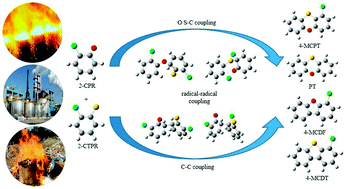The homogeneous gas-phase formation mechanisms of PCPTs/PCDTs/PCDFs from the radical/radical cross-condensation of 2-CPR and 2-CTPR: a theoretical, mechanistic and kinetics study†
Abstract
Polychlorinated phenoxathiins (PCPTs) are one group of dioxin-like compounds, which can be considered to be one-oxygen-substituted polychlorinated thianthrene (PCTA) compounds or one-sulfur-substituted polychlorinated dibenzo-p-dioxin (PCDD) compounds. Owing to their high toxicity and wide distribution, clarifying the formation and emission of PCPTs due to combustion and thermal processes can deepen our understanding of the dioxin formation mechanism and allow reduced-emission and dioxin-control strategies to be established. Chlorophenols (CPs) and chlorothiophenols (CTPs) are direct precursors in PCPT formation. In this paper, the homogeneous gas-phase formation mechanisms of PCPTs, as well as polychlorinated dibenzofurans (PCDFs) and polychlorinated dibenzothiophenes (PCDTs), from the cross-condensation of 2-chlorophenoxy radicals (2-CPRs) and 2-chlorothiophenoxy radicals (2-CTPRs) under thermal and combustion conditions were investigated theoretically using a density functional theory (DFT) method. The reaction priorities and effects of water molecules on the formation mechanisms were discussed. The rate constants of crucial elementary steps were calculated from 600–1200 K. The acute and chronic toxicities of the main products were predicted at three trophic levels. This study shows that routes starting with oxygen–carbon condensation are favored over those starting with sulfur–carbon condensation for PCPT formation, and routes ending with Cl loss can occur more easily than those ending with H loss. Water molecules have a negative catalytic effect on CH–S H-transfer steps but a positive catalytic effect on CH–O H-transfer steps.



 Please wait while we load your content...
Please wait while we load your content...